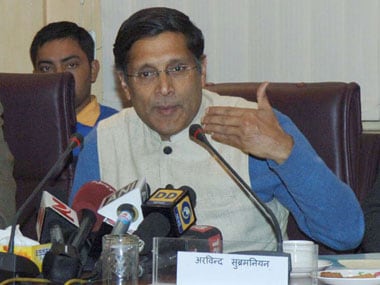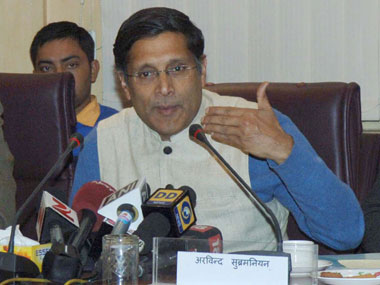Chief Economic Advisor (CEA)
Arvind Subramanian made several points in his interview to the media
yesterday (26 May). One, there was a strong case for interest rate cuts, with inflation under control and fiscal consolidation well underway; and, two, when major competitors were aggressively cutting interest rates to keep their currencies competitive, India cannot be a holdout. He is bang-on on the first point, and the second reason – to make the currency competitive – should not be invoked as it can be a double-edged sword. A rupee that falls due to perceptions about an expansionary monetary policy will add to imported inflation, even if it helps exports. It is thus best to not use the need for a weaker currency as an argument for cutting rates. The case for rate cuts – a steep cut of upto one percent this year and another one percent next year depending on inflation trends – has never been stronger. Looking purely at inflation indices and the anaemic rate of industrial growth, it is an absolute no-brainer for the Reserve Bank of India (RBI). While the Consumer Prices Index (CPI) is disinflating rapidly (it was at 4.87 percent in April) despite a fall in agricultural output last year, the Wholesale Prices Index (WPI) is actually deflating (at -2.67 percent, prices are actually tumbling as opposed to merely slowing down their rate of increase). The CEA’s case for easing the price of money stands even without bringing in the currency argument for the simple reason that India’s growth story this time will have to de domestically led. The price of the rupee will be determined by capital flows, and there is no need to move towards active management of the currency rate in response to global developments. [caption id=“attachment_2046031” align=“alignleft” width=“380”]
 Chief Economic Adviser Arvind Subramanian. Image courtesy PIB[/caption] Bank interest rates now offer a hugely positive real rate of interest. Savers are getting a clean 3-4 percent more than inflation (one-year FD rates hover around 8-8.5 percent), while borrowers are paying usurious real interest rates upwards of 6 percent when demand is weak and holding unsold inventory costs a bomb. Current bank base rates are in the range of 9.75-10.25 percent, and actual borrowing costs are higher for all but the bluest of blue chip borrowers. At such high levels of real returns, no infrastructure project will be viable. Simple reason: when banks can earn 3 percent plus real returns on 10-year government bonds (current yield 7.7 percent) which need no additional capital, why would they want to lend to risky infrastructure projects, manufacturing industry or services which require banks to provide more capital? This, at a time when they are already stuck with over Rs 3,00,000 crore of bad loans. If all this does not make an impregnable argument for rate cuts, then we might as well stop discussing the issue. In case he is still not convinced, RBI Governor Raghuram Rajan should consider these additional facts. First, the RBI’s job is not merely to fight inflation but also guard the health of the banking system. A big rate cut will give banks huge treasury gains as the valuations of government securities held in their portfolios rises. These profits can be booked in the P&L accounts, allowing banks to clean up their bad loans portfolio by writing off some of the worst cases, and providing more for the rest. Second, the RBI is the government’s banker and debt manager. It makes no sense for it to allow the government to borrow at high real interest rates when inflation is falling. It will make the task of managing the fiscal deficit much more difficult at a time when the case for higher rates due to inflation has collapsed. Rajan and Finance Minister Arun Jaitley need to do a simple, sensible deal: Rajan should cut rates quickly, and sharply, and Jaitley should use the saving on interest rates on government bonds to recapitalise banks quickly. This would be a win-win-win deal, warranted by objective macroeconomic conditions. Banks would benefit, the government would benefit, and industry would benefit. There is a good case for cutting rates by 50 basis points (half a percent) on 2 June, when Rajan conducts his next monetary policy review. He has to be bolder than he has been so far. He has to abandon his fear of inflation when it is nowhere in sight.
Chief Economic Adviser Arvind Subramanian. Image courtesy PIB[/caption] Bank interest rates now offer a hugely positive real rate of interest. Savers are getting a clean 3-4 percent more than inflation (one-year FD rates hover around 8-8.5 percent), while borrowers are paying usurious real interest rates upwards of 6 percent when demand is weak and holding unsold inventory costs a bomb. Current bank base rates are in the range of 9.75-10.25 percent, and actual borrowing costs are higher for all but the bluest of blue chip borrowers. At such high levels of real returns, no infrastructure project will be viable. Simple reason: when banks can earn 3 percent plus real returns on 10-year government bonds (current yield 7.7 percent) which need no additional capital, why would they want to lend to risky infrastructure projects, manufacturing industry or services which require banks to provide more capital? This, at a time when they are already stuck with over Rs 3,00,000 crore of bad loans. If all this does not make an impregnable argument for rate cuts, then we might as well stop discussing the issue. In case he is still not convinced, RBI Governor Raghuram Rajan should consider these additional facts. First, the RBI’s job is not merely to fight inflation but also guard the health of the banking system. A big rate cut will give banks huge treasury gains as the valuations of government securities held in their portfolios rises. These profits can be booked in the P&L accounts, allowing banks to clean up their bad loans portfolio by writing off some of the worst cases, and providing more for the rest. Second, the RBI is the government’s banker and debt manager. It makes no sense for it to allow the government to borrow at high real interest rates when inflation is falling. It will make the task of managing the fiscal deficit much more difficult at a time when the case for higher rates due to inflation has collapsed. Rajan and Finance Minister Arun Jaitley need to do a simple, sensible deal: Rajan should cut rates quickly, and sharply, and Jaitley should use the saving on interest rates on government bonds to recapitalise banks quickly. This would be a win-win-win deal, warranted by objective macroeconomic conditions. Banks would benefit, the government would benefit, and industry would benefit. There is a good case for cutting rates by 50 basis points (half a percent) on 2 June, when Rajan conducts his next monetary policy review. He has to be bolder than he has been so far. He has to abandon his fear of inflation when it is nowhere in sight.
CEA Arvind Subramanian is right: Rajan should stop being a shrinking lily on rate cuts
R Jagannathan
• May 27, 2015, 12:19:22 IST
His earlier caution on rate cuts was warranted by fears that inflation could revive. But Raghuram Rajan has no reason left for caution anymore. CEA Arvind Subramanian is right to call for rate cuts
Advertisement
)